Adopting Circular Economy at the European Union Level and Its Impact on Economic Growth
Abstract
:1. Introduction
2. Materials and Methods
2.1. Research Methodology
2.2. Description of the Circular Economy at the EU Level
3. Results
- Development of the regression model;
- Estimating model parameters; and
- Checking the accuracy of the results.
- Y = GDP per capita growth;
- X1 = labor productivity;
- X2 = labor force engaged production of environmental goods;
- X3 = recycling rate of municipal waste;
- X4 = the share of innovative enterprises that have brought innovative new products with environmental benefits to the market;
- X5 = use of renewable energy.
4. Discussion
5. Conclusions
Funding
Conflicts of Interest
References
- Ayres, Robert. 1995. Life cycle analysis: A critique. Resources, Conservation and Recycling 14: 199–223. [Google Scholar]
- Biber-Freudenberger, Lisa, Amit Kumar Basukala, Martin Bruckner, and Jan Börner. 2018. Sustainability Performance of National Bio-Economies. Sustainability 10: 2705. [Google Scholar] [CrossRef]
- Block, Joern. 2009. Long-Term Orientation of Family Firms: An Investigation of R&D Investments, Downsizing Practices, and Executive Pay. Wiesbaden: Gabler, Available online: https://link.springer.com/book/10.1007/978-3-8349-8412-8 (accessed on 18 March 2019).
- Blomsma, Fenna, and Geraldine Brennan. 2017. The emergence of circular economy: A new framing around prolonging resource productivity. Journal of Industrial Ecology 21: 603–14. [Google Scholar] [CrossRef]
- Bocken, Nancy, Ingrid de Pauw, Conny Bakker, and Bram van der Grinten. 2016. Product design and business model strategies for a circular economy. Journal of Industrial and Production Engineering 33: 308–20. [Google Scholar] [CrossRef]
- Brock, William, and Scott Taylor. 2005. Economic Growth and the Environment: A Review of Theory and Empirics. In Handbook of Economic Growth. vol. 1, pp. 1749–821. Available online: http://www.sciencedirect.com/science/article/pii/S1574068405010282 (accessed on 14 February 2019).
- Browne, David, Bernadette O’Regan, and Richard Moles. 2009. Use of carbon footprinting to explore alternative household waste policy scenarios in an Irish city-region. Resources, Conservation and Recycling 54: 113–22. [Google Scholar] [CrossRef]
- Cappa, Francesco., Jeffrey Laut, Oded Nov, Luca Giustiniano, and Maurizio Porfiri. 2016. Activating social strategies: Face-to-face interaction in technology-mediated citizen science. Journal of Environment Management 182: 374–84. [Google Scholar] [CrossRef]
- Chang, Ni-Bin. 2008. Economic and policy instrument analyses in support of the scrap tire recycling program in Taiwan. Journal of Environmental Management 86: 435–50. [Google Scholar] [CrossRef] [PubMed]
- Clodnitchi, Roxana, and Busu Cristian. 2017. Energy poverty in Romania–drivers, effects and possible measures to reduce its effects and number of people affected. Paper presented at International Conference on Business Excellence, Bucharest, Romania, March 21–22; vol. 11, pp. 138–45. [Google Scholar]
- Cotae, Catrinel Elena. 2015. Regional performances in the context of a transition towards the circular economy: Structuring the assessment framework. Ecoforum Journal 4. Available online: http://ecoforumjournal.ro/index.php/eco/article/view/222 (accessed on 18 August 2017).
- De Wolf, Catherine, Francesco Pomponi, and Alice Moncaster. 2017. Measuring embodied carbon dioxide equivalent of buildings: A review and critique of current industry practice. Energy and Buildings 140: 68–80. [Google Scholar] [CrossRef]
- Eco-Innovation and Competitiveness Annual Report. 2017. Available online: http://eco.nomia.pt/contents/documentacao/kh0414991enn-002.pdf (accessed on 13 May 2019).
- EU. 2002. Regulation (EC) No 2150/2002 of the European Parliament and the Council on Waste Statistics. Available online: http://www.kluwerlawonline.com/abstract.php?id=EELR2003019 (accessed on 23 December 2018).
- Eurostat. 2017. Eurostat. Your Key to European Statistics. Available online: http://ec.europa.eu/eurostat (accessed on 24 September 2018).
- Eviews. 2017. User Guide. version 10.0. Irvine: QMS Quantitative Micro Software, pp. 140–41. [Google Scholar]
- Geissdoerfer, Martin, Paulo Savaget, Nancy Bocken, and Erik Jan Hultink. 2017. The Circular Economy—A new sustainability paradigm? Journal of Cleaner Production 143: 757–68. [Google Scholar] [CrossRef]
- Geng Yong, Jia Fu, Joseph Sarkis, and Bing Xue. 2012. Towards a national circular economy indicator system in China: An evaluation and critical analysis. Journal of Cleaner Production 23: 216–24. [Google Scholar] [CrossRef]
- George, Donald Ar, Brian Chi-ang Lin, and Yunmin Chen. 2015. A circular economy model of economic growth. Environmental Modelling & Software 73: 60–63. [Google Scholar]
- Ghisellini, Patrizia, Catia Cialani, and Sergio Ulgiati. 2016. A review on circular economy: The expected transition to a balanced interplay of environmental and economic systems. Journal of Cleaner Production 114: 11–32. [Google Scholar] [CrossRef]
- Gopal, Anandasivam, Manu Goyal, Serguei Netessine, and Matthew Reindorp. 2013. The impact of new product introduction on plant productivity in the North American automotive industry. Management Science 59: 2217–36. [Google Scholar] [CrossRef]
- Grossman, Gene, and Alan Krueger. 1995. Economic growth and the environment. The Quarterly Journal of Economics 110: 353–77. [Google Scholar] [CrossRef]
- Haas, Willi, Fridolin Krausmann, Dominik Wiedenhofer, and Markus Heinz. 2015. How circular is the global economy?: An assessment of material flows, waste production, and recycling in the European Union and the world in 2005. Journal of Industrial Ecology 19: 765–77. [Google Scholar] [CrossRef]
- Kirchherr, Julian, Denise Reike, and Marko Hekkert. 2017. Conceptualizing the circular economy: An analysis of 114 definitions. Resources. Conservation and Recycling 127: 221–32. [Google Scholar] [CrossRef]
- Lundvall, Bengt-Ake. 1996. The Social Dimension of the Learning Economy. Available online: https://pdfs.semanticscholar.org/202b/775ebcdbcaf8fd7c052f9a37a23776a3ea13.pdf (accessed on 7 May 2018).
- Lyasnikov, Nikolay Vasilievich, Mikhail Nikolaevich Dudin, Vladimir Dmitriyevich Sekerin, Mikhail Yakovlevici Veselovsky, and Vera Grigoryevna Aleksakhina. 2014. The national innovation system: The conditions of its making and factors in its development. Life Science Journal 11: 535–38. [Google Scholar]
- McDonough, William, and Michael Braungart. 2002. Cradle to Cradle: Remaking the Way We Make Things. New York: North Point Press. [Google Scholar]
- Porter, Michael, and Claas Van der Linde. 1995. Toward a new conception of the environment-competitiveness relationship. Journal of Economic Perspectives 9: 97–118. [Google Scholar] [CrossRef]
- Preston, Felix. 2012. A Global Redesign? Shaping the Circular Economy. London: Chatham House, Available online: https://www.bitcni.org.uk/wp-content/uploads/2014/11/bp0312_preston.pdf (accessed on 11 April 2019).
- Puigcerver-Peñalver, Mari Carmen. 2007. The impact of structural funds policy on European regions’ growth. A theoretical and empirical approach. The European Journal of Comparative Economics 4: 179. [Google Scholar]
- Schmidheiny, Kurt. 2016. Panel Data: Fixed and Random Effects. Basel Universität. Available online: http://www.schmidheiny.name/teaching/panel2up.pdf (accessed on 18 December 2017).
- Sjöström, Magnus, and Goran Östblom. 2009. FutureWaste Scenarios for Sweden Based on a CGEmodle. Working Paper 109, National Institute of Economic Research, Stockholm, Sweden. Available online: https://econpapers.repec.org/paper/hhsnierwp/0109.htm (accessed on 11 January 2019).
- Sofian, Saudah, Mike Tayles, and Richard Pike. 2017. The implications of intellectual capital on performance measurement and corporate performance. Jurnal Kemanusiaan 4: 13–24. [Google Scholar]
- Su, Biwei, Almas Heshmati, and Yong Geng. 2013. A review of the circular economy in China: Moving from rhetoric to implementation. Journal of Cleaner Production 42: 215–27. [Google Scholar] [CrossRef]
- Urban, Markus. 2015. The Influence of Blockholders on Agency Costs and Firm Value an Empirical Examination of Blockholder Characteristics and Interrelationships for German Listed Firms. Berlin and Heidelberg: Springer. [Google Scholar]
- Weinberg, Diana, and Abraham Carmeli. 2008. Exploring the antecedents of relationship commitment in an import–export dyad. In New Perspectives in International Business Research. Edited by Maryann Feldman and Grazia Santangelo. Bingley: Emerald, pp. 113–36. [Google Scholar]
- Zink, Trevor, and Roland Geyer. 2017. Circular economy rebound. Journal of Industrial Ecology 21: 593–602. [Google Scholar] [CrossRef]
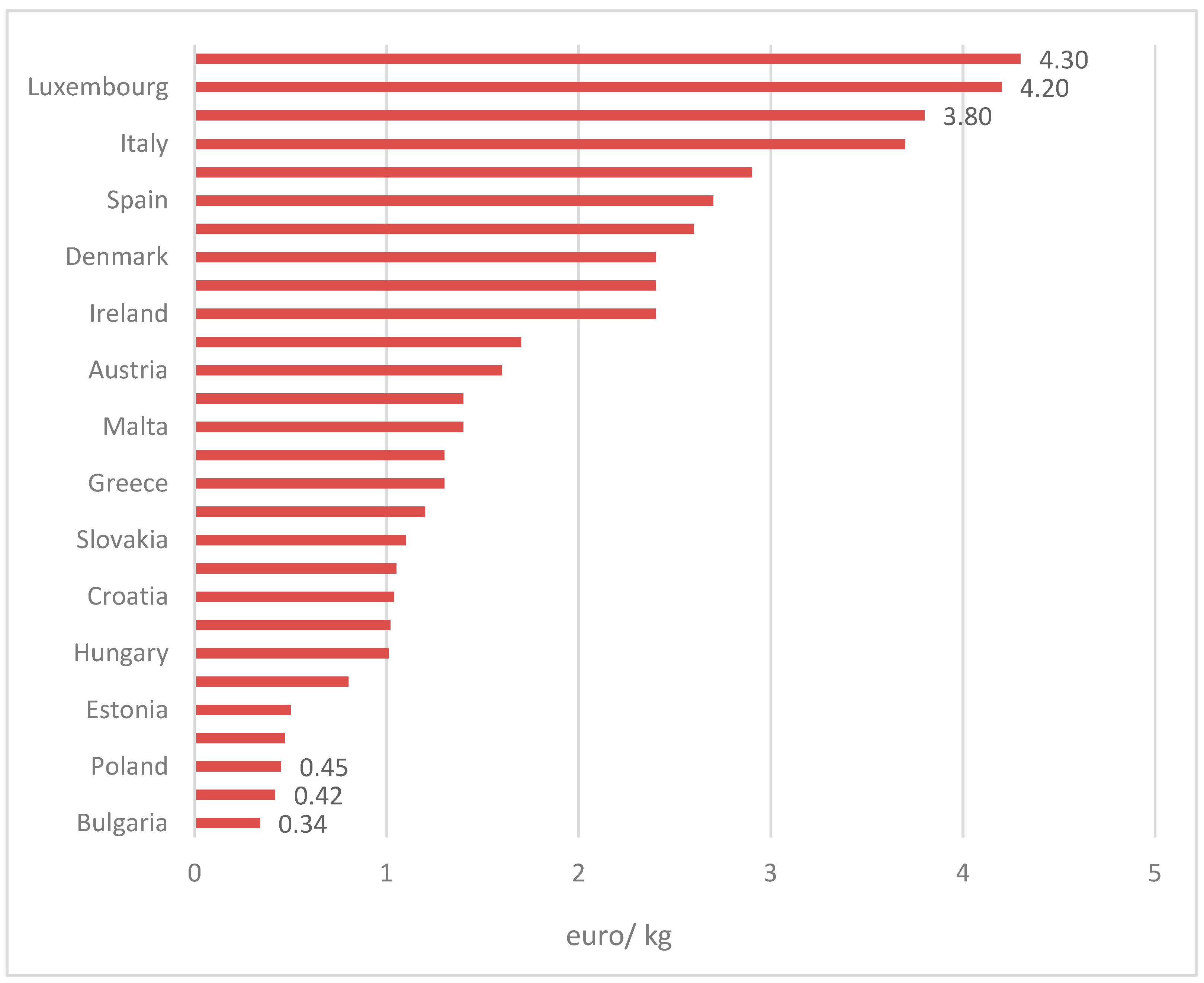
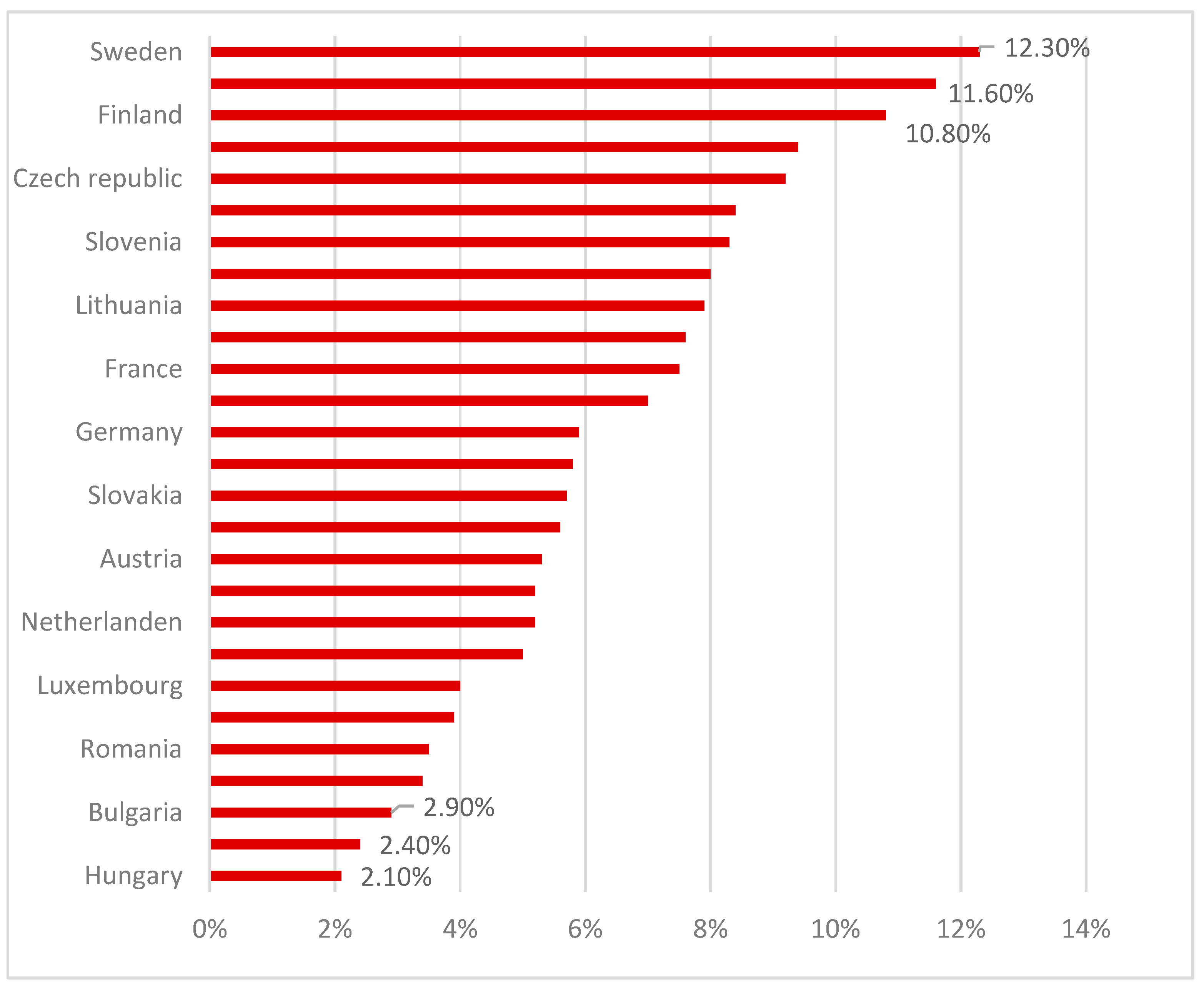
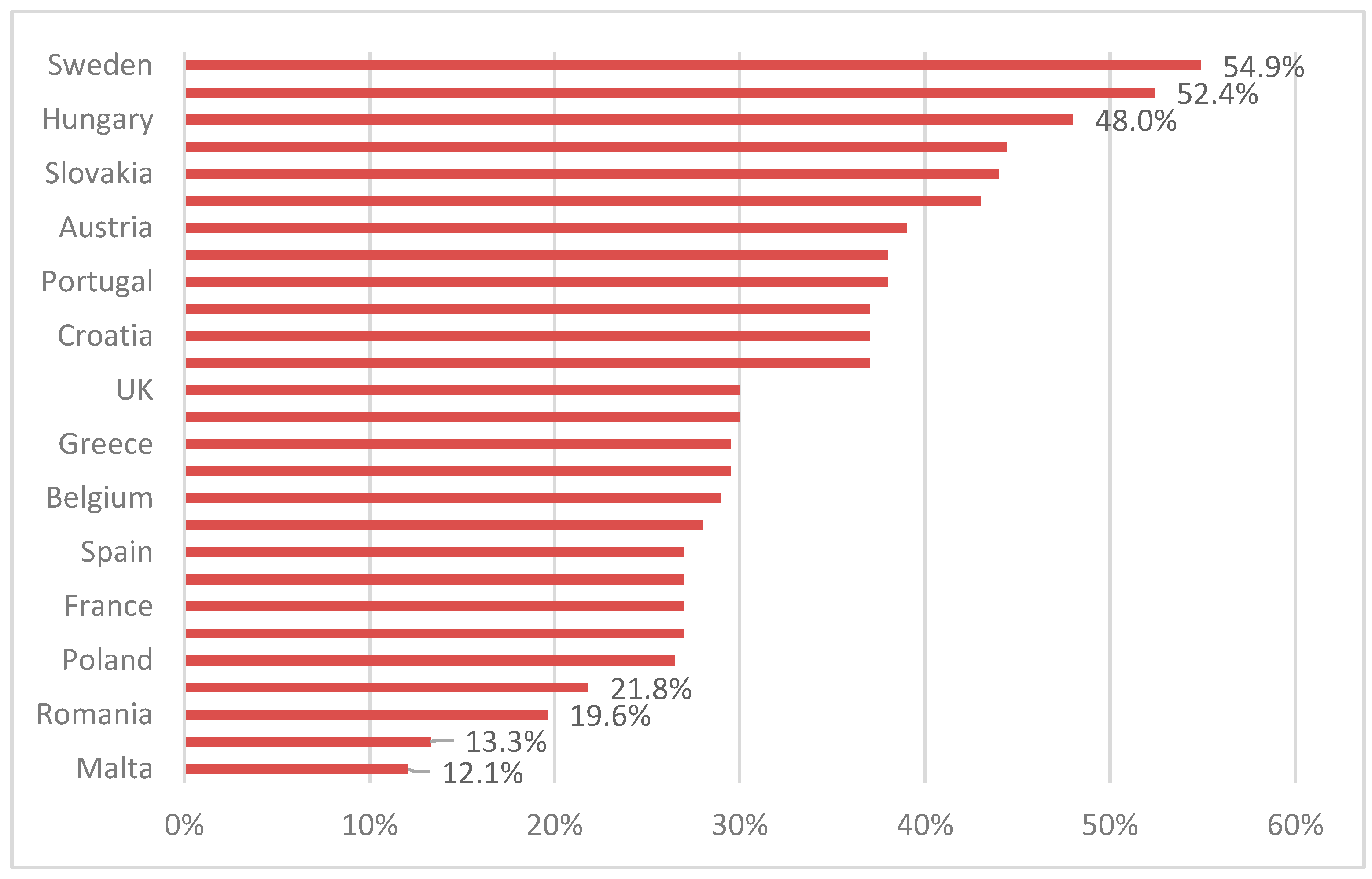
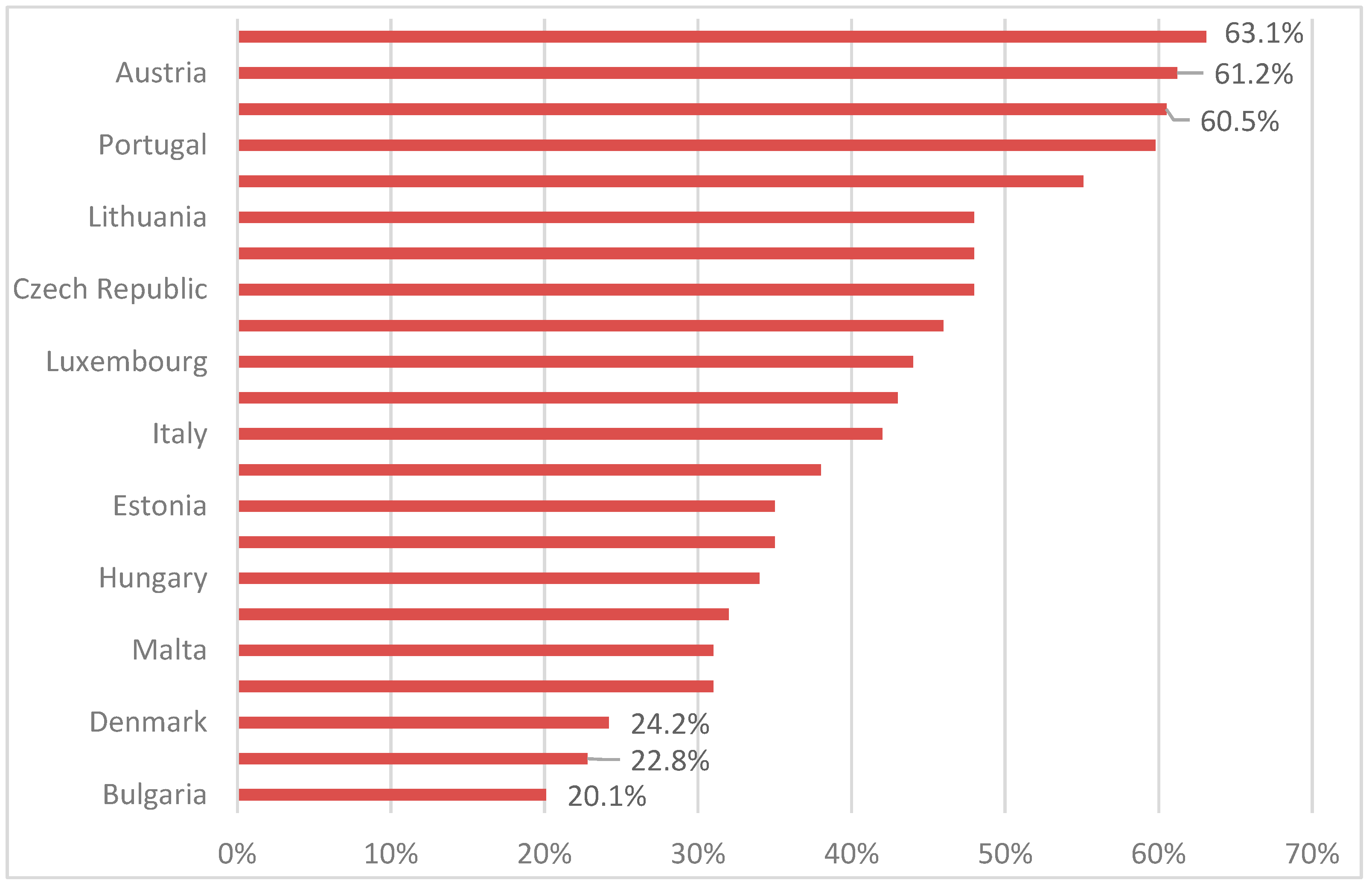
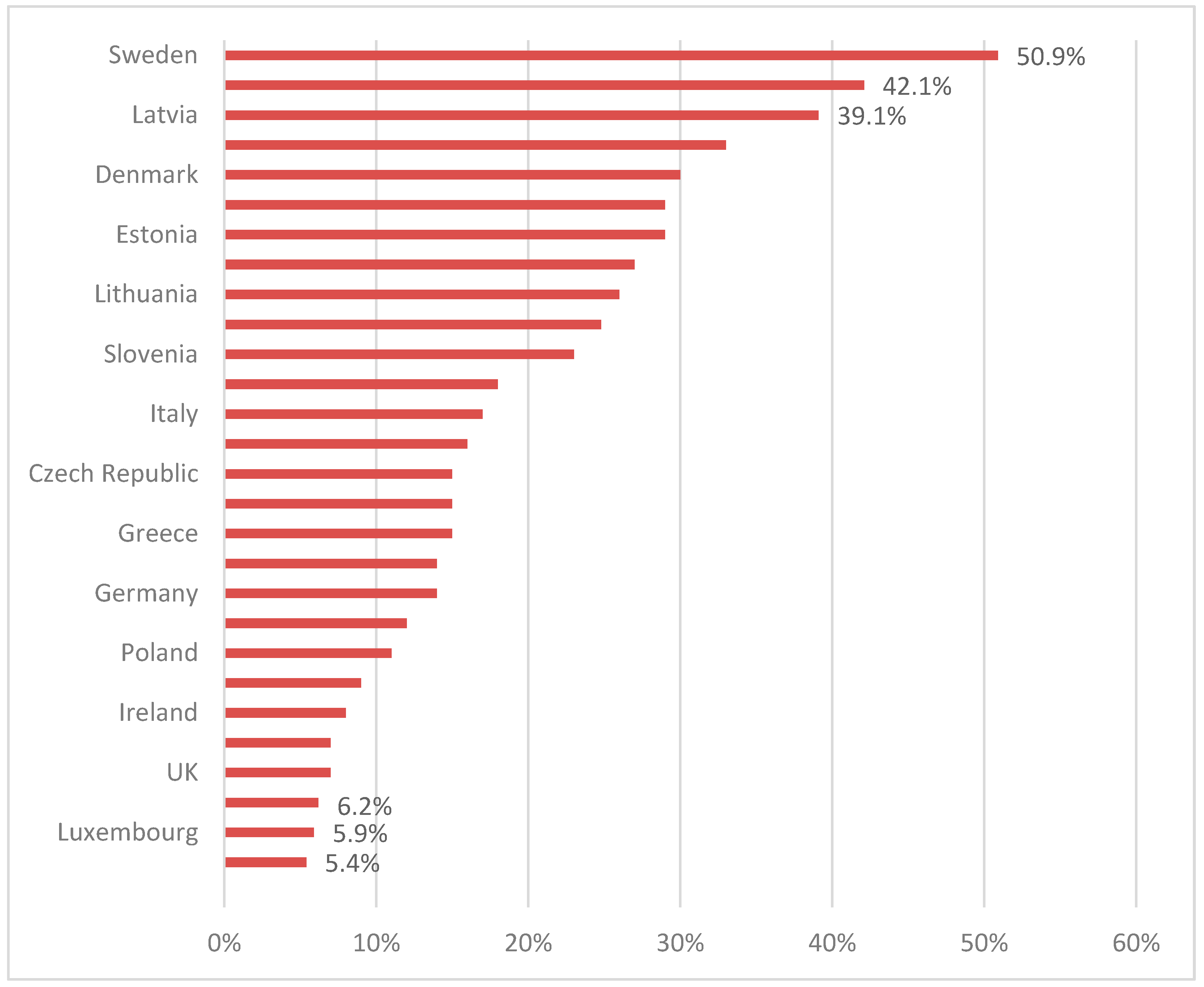
| Hypothesis 1 | European Union (EU) member states with a higher number of employees in the field of the production of goods for environmental protection have higher economic growth. |
| Hypothesis 2 | Renewable energy use at the EU level has a significant and strong impact on economic growth. |
| Hypothesis 3 | Innovative enterprises with big market shares in the EU member states which have brought innovative new products with environmental benefits to the market have a greater impact on economic growth. |
| Variable | Mean | Median | Standard Deviation | N |
|---|---|---|---|---|
| Y | 0.2014 | 0.1942 | 0.1043 | 27 |
| X1 | 8.9432 | 8.9753 | 3.3022 | 27 |
| X2 | 0.1520 | 0.2013 | 0.0834 | 27 |
| X3 | 0.6012 | 0.7021 | 0.1027 | 27 |
| X4 | 0.9021 | 0.8042 | 0.0702 | 27 |
| X5 | 0.8124 | 0.9324 | 0.0987 | 27 |
| Variable | Y | X1 | X2 | X3 | X4 | X5 |
|---|---|---|---|---|---|---|
| Y | 1 | 0.702 | 0.539 | 0.616 | 0.632 | 0.792 |
| X1 | 0.702 | 1 | 0.028 | 0.034 | 0.112 | 0.109 |
| X2 | 0.602 | 0.034 | 1 | 0.052 | 0.106 | 0.078 |
| X3 | 0.598 | 0.028 | 0.048 | 1 | 0.079 | 0.081 |
| X4 | 0.623 | 0.112 | 0.106 | 0.079 | 1 | 0.102 |
| X5 | 0.792 | 0.109 | 0.078 | 0.081 | 0.102 | 1 |
| F Statistics | 3.56 |
| F Stat. prob. | 0.210 |
| Cross Section | Time | Both | |
|---|---|---|---|
| Coefficient | 32.23 | 54.324 | 89.65 |
| Probability | 0.089 | 0.567 | 0.035 |
| Dependent Variable: GDP_CAPITA_GROWTH | ||||
| Method: Pooled least squares | ||||
| Sample: 2008–2017 | ||||
| Total panel observations: 270 GDP_CAPITA_GROWTH = C(1) + C(2) × ROD_OF_RES + C(3) × ENVIRON_EMPL + C(4) × REC_RATE + C(5) × ENVIRON_INNOV + C(6) × RENEWABLE | ||||
| Coefficient | Std. Error | t-Statistic | Prob. | |
| C | −1.9335 | 1.245 | 3.252243 | 0.0084 |
| Prod_of_res | 1.734502 | 1.430 | 3.58543 | 0.0045 |
| Environ_Empl | 1.168740 | 1.320 | 4.188850 | 0.0053 |
| Rec_Rate | 0.457692 | 1.012 | 4.821022 | 0.0047 |
| Environ_Innov | 0.503238 | 0.795 | 3.328985 | 0.0310 |
| Renewable | 0.687912 | 1.768 | 4.567883 | 0.0210 |
| R-squared | 0.798652 | Mean dependent var | 8.7892 | |
| Adjusted R-squared | 0.824678 | S.D. dependent var | 0.6043 | |
| S.E. of regression | 0.098723 | Akaike info criterion | 1.8023 | |
| Sum squared resid | 1.408763 | Schwarz criterion | 1.7098 | |
| Log likelihood | 119.3076 | Hannan–Quinn criter. | 1.6987 | |
| Durbin–Watson stat | 2.088790 | |||
| Hypothesis | Validated (Yes/No) |
|---|---|
| Hypothesis 1 | Yes |
| Hypothesis 2 | Yes |
| Hypothesis 3 | Yes |
© 2019 by the author. Licensee MDPI, Basel, Switzerland. This article is an open access article distributed under the terms and conditions of the Creative Commons Attribution (CC BY) license (http://creativecommons.org/licenses/by/4.0/).
Share and Cite
Busu, M. Adopting Circular Economy at the European Union Level and Its Impact on Economic Growth. Soc. Sci. 2019, 8, 159. https://doi.org/10.3390/socsci8050159
Busu M. Adopting Circular Economy at the European Union Level and Its Impact on Economic Growth. Social Sciences. 2019; 8(5):159. https://doi.org/10.3390/socsci8050159
Chicago/Turabian StyleBusu, Mihail. 2019. "Adopting Circular Economy at the European Union Level and Its Impact on Economic Growth" Social Sciences 8, no. 5: 159. https://doi.org/10.3390/socsci8050159
APA StyleBusu, M. (2019). Adopting Circular Economy at the European Union Level and Its Impact on Economic Growth. Social Sciences, 8(5), 159. https://doi.org/10.3390/socsci8050159





